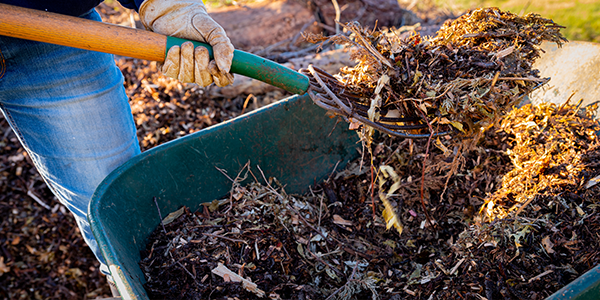Spreading or installing mulch may seem like a simple task, but there are a few things you can do to maximize its potential. Mulch is an excellent organic weed barrier that also decomposes slowly over time and if properly layered, adds nitrogen and nutrients to your soil. Discover our top 5 mulch installation tips to have a beautifully mulched landscape.
Clear the Mulch Installation Area
First, you will want to thoroughly clean the area from any existing leaves, sticks, and debris from your installation area. You should also take time to remove any existing weeds or dying plants. We recommend hand-picking weeds. Be sure to grab the weed from its root to prop the entire weed out so it will no longer proliferate. You should also take time to trim any nearby bushes and trees.
Rake and Prep the Soil
If this is an area where you plan to add plants, it should be properly prepped. The installation area can be raised bed that will house fruits and vegetables or an island bed integrated with annuals and perennials. You can also use mulch to create a makeshift walkway. Regardless, you will want to rake the area to loosen any clumped soil.
Next, flatten the soil to create a level surface using the back of a shovel. Use a weedwhacker to define the edges if you want a clean look. If you are growing plants, we recommend taking the time to enrich the soil with compost, topsoil, and fertilizer.

Edge the Mulch Installation Area and Add Landscape Fabric
If you are not mulching an area that is already defined by clear boundaries such as a raised bed, we recommend edging the area. To install the edging, you will need to dig a three inch deep uniform trench along the perimeter of the mulch installation area. Next, insert the edging following the natural curves and shape of the perimeter and pack it down with soil. Trim any excess edging and then anchor it down using edging stakes.
You should also consider using landscape fabric as the second type of weed barrier. Simply lay the fabric down along the surface of the soil, trim off any excess, and pin it down using landscape staples.
Select a Mulch to Best Suit Your Needs
There are various types of mulch you can use, and they all have varying benefits and aesthetic impacts. There are two main forms of mulch: organic and inorganic. Organic mulch comprises bark, wood chip, wood nuggets, and straw. It will decompose over time and can be layered with one another. For example, in a raised bed, you can first layer straw during the seedling stage. As the plants grow, you can add a top layer of bark mulch. Inorganic mulch such as gravel, lava rock, and sand will stand the test of time and be a long-term investment.
Install the Mulch Efficiently
To ease the process, we recommend adding small piles of your desired mulch throughout the installation area. It can be easily spread with a rake and pressed flush against the soil with your hands. If you are using an organic mulch, we recommend only layer 2-3 inches of material. If you are using an inorganic mulch, you should lay only 1-2 inches. Be cautious around any existing plants. You should leave sufficient space around the base of the plant to not harm its root system.
If you need further assistance on what mulch best fits your needs, we would be happy to assist you. Visit Kurtz Bros., Inc. for more information or contact us to learn more!
